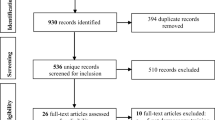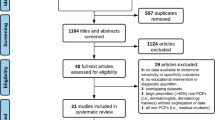Abstract
Background
Dermoscopy is a widely used technique, recommended in clinical practice guidelines worldwide for the early diagnosis of skin cancers. Intra-European disparities are reported for early detection and prognosis of skin cancers, however, no information exists about regional variation in patterns of dermoscopy use across Europe.
Objective
To evaluate the regional differences in patterns of dermoscopy use and training among European dermatologists.
Materials & Methods
An online survey of European-registered dermatologists regarding dermoscopy training, practice and attitudes was established. Answers from Eastern (EE) versus Western European (WE) countries were compared and their correlation with their respective countries’ gross domestic product/capita (GDPc) and total and government health expenditure/capita (THEc and GHEc) was analysed.
Results
We received 4,049 responses from 14 WE countries and 3,431 from 18 EE countries. A higher proportion of WE respondents reported dermoscopy use (98% vs. 77%, p<0.001) and training during residency (43% vs. 32%) or anytime (96.5% vs. 87.6%) (p<0.001) compared to EE respondents. The main obstacles in dermoscopy use were poor access to dermoscopy equipment in EE and a lack of confidence in one’s skills in WE. GDPc, THEc and GHEc correlated with rate of dermoscopy use and dermoscopy training during residency (Spearman rho: 0.5–0.7, p<0.05), and inversely with availability of dermoscopy equipment.
Conclusion
The rates and patterns of dermoscopy use vary significantly between Western and Eastern Europe, on a background of economic inequality. Regionally adapted interventions to increase access to dermoscopy equipment and training might enhance the use of this technique towards improving the early detection of skin cancers.
Similar content being viewed by others
References
Argenziano G, Albertini G, Castagnetti F, et al. Early diagnosis of melanoma: what is the impact of dermoscopy? Dermatol Ther 2012; 25: 403–9.
Argenziano G, Cerroni L, Zalaudek I, et al. Accuracy in melanoma detection: a 10-year multicenter survey. J Am Acad Dermatol 2012; 67: 54–9.
Argenziano G, Puig S, Zalaudek I, et al. Dermoscopy improves accuracy of primary care physicians to triage lesions suggestive of skin cancer. Journal of Clinical Oncology 2006; 24: 1877–82.
Menzies SW, Emery J, Staples M, et al. Impact of dermoscopy and short-term sequential digital dermoscopy imaging for the management of pigmented lesions in primary care: a sequential intervention trial.ß r J Dermatol 2009; 161: 1270–7.
Vestergaard M, Macaskill P, Holt P, et al. Dermoscopy compared with naked eye examination for the diagnosis of primary melanoma: a meta-analysis of studies performed in a clinical setting. Br J Dermatol 2008; 159: 669–76.
Wouters MW, Michielin O, Bastiaannet E, et al. ECCO essential requirements for quality cancer care: Melanoma. Crit Rev Oncol Hematol 2018; 122: 164–78.
Watts CG, Dieng M, Morton RL, et al. Clinical practice guidelines for identification, screening and follow-up of individuals at high risk of primary cutaneous melanoma: a systematic review. Br J Dermatol 2015; 172: 33–47.
Garbe C, Peris K, Hauschild A, et al. Diagnosis and treatment of melanoma. European consensus-based interdisciplinary guideline — Update 2016.
Swetter SM, Tsao H, Bichakjian CK, et al. Guidelines of care for the management of primary cutaneous melanoma. J Am Acad Dermatol 2019; 80: 208–50.
Crocetti E, Mallone S, Robsahm TE, et al. Survival of patients with skin melanoma in Europe increases further: Results of the EUROCARE-5 study. Eur J Cancer 2015; 51: 2179–90.
Forsea AM, Del Marmol V, de Vries E, et al. Melanoma incidence and mortality in Europe: new estimates, persistent disparities. Br J Dermatol 2012; 167: 1124–30.
Forsea AM, Del Marmol V, Stratigos A, et al. Melanoma prognosis in Europe: far from equal. Br J Dermatol 2014; 171: 179–82.
Barbaric J, Sekerija M, Agius D, et al. Disparities in melanoma incidence and mortality in South-Eastern Europe: Increasing incidence and divergent mortality patterns. Is progress around the corner? Eur J Cancer 2016; 55: 47–55.
de Vries E, Boniol M, Dore JF, et al. Lower incidence rates but thicker melanomas in Eastern Europe before 1992: a comparison with Western Europe. Eur J Cancer 2004; 40: 1045–52.
Kandolf-Sekulovic L, Zivkovic-Perisic S, Radevic T, et al. Melanoma in South-East Europe: epidemiological data from the central cancer registry and clinicopathological characteristics from the hospital-based registry in Serbia. Int J Dermatol 2012; 51: 1186–94.
Forsea AM, Del Marmol V, Geller AC. Priorities and challenges for skin cancer prevention in Europe: an expert survey. Melanoma Res 2013; 23: 298–306.
Astrua C, Fava P, Brizio M, et al. A study of melanoma in Eastern European migrants in Italy. Eur J Dermatol 2017; 27: 139–43.
Forsea AM, Tschandl P, Del Marmol V, et al. Factors driving the use of dermoscopy in Europe: A Pan-European survey. Br J Dermatol 2016.
Forsea AM, Tschandl P, Zalaudek I, et al. The impact of dermoscopy on melanoma detection in the practice of dermatologists in Europe: results of a pan-European survey. J Eur Acad Dermatol Venereol 2017; 31: 1148–56.
United Nations Statistics Division, available at http://unstats.un.org/unsd/methods/m49/m49regin.htm#europe, accessed on 20.02.2016.
WHO Europe, available at http://www.euro.who.int/en/countries, accessed on 07/2017.
De Angelis R, Sant M, Coleman MP, et al. Cancer survival in Europe 1999–2007 by country and age: results of EUROCARE-5-α population-based study. Lancet Oncol 2014; 15: 23–34.
EUROSTAT. Database available at https://ec.europa.eu/eurostat/data/database, last accessed July 2018. In.
World Health Organization. Global Health Expenditure Database, available at https://apps.who.int/nha/database, accessed last july 2019. In.
Team RC. R: A language and environment for statistical computing. In. URL: https://www.R-project.org/: R Foundation for Statistical Computing, Vienna, Austria. 2015.
Holm S. A simple sequentially rejective multiple test procedure. Scandinavian Journal of Statistics 1979; 6: 65–70.
Argenziano G, Moscarella E, Annetta A, et al. Melanoma detection in Italian pigmented lesion clinics. G Ital Dermatol Venereol 2014; 149: 161–6.
Carli P, De Giorgi V, Crocetti E, et al. Improvement of malignant/benign ratio in excised melanocytic lesions in the ‘dermoscopy era’: a retrospective study 1997–2001. Br J Dermatol 2004; 150: 687–92.
Moloney FJ, Guitera P, Coates E, et al. Detection of primary melanoma in individuals at extreme high risk: a prospective 5-year follow-up study. JAMA Dermatol 2014; 150: 819–27.
Tromme I, Devleesschauwer B, Beutels P, et al. Selective use of sequential digital dermoscopy imaging allows a cost reduction in the melanoma detection process: a belgian study of patients with a single or a small number of atypical nevi. PLoS One 2014; 9: e109339.
Carli P, Quercioli E, Sestini S, et al. Pattern analysis, not simplified algorithms, is the most reliable method for teaching dermoscopy for melanoma diagnosis to residents in dermatology. Br J Dermatol 2003; 148: 981–4.
Arnold M, Holterhues C, Hollestein LM, et al. Trends in incidence and predictions of cutaneous melanoma across Europe up to 2015. J Eur Acad Dermatol Venereol 2014; 28: 1170–8.
de Vries E, Coebergh JW. Cutaneous malignant melanoma in Europe. Eur J Cancer 2004; 40: 2355–66.
Breton AL, Amini-Adle M, Duru G, et al. Overview of the use of dermoscopy in academic and non-academic hospital centres in France: a nationwide survey. J Eur Acad Dermatol Venereol 2014; 28: 1207–13.
Moulin C, Poulalhon N, Duru G, et al. Dermoscopy use by French private practice dermatologists: a nationwide survey. Br J Dermatol 2013; 168: 74–9.
Butler TD, Matin RN, Affleck AG, et al. Trends in dermoscopy use in the UK: results from surveys in 2003 and 2012. Dermatol Pract Concept 2015; 5: 29–38.
van der Rhee JI, Bergman W, Kukutsch NA. The impact of dermoscopy on the management of pigmented lesions in everyday clinical practice of general dermatologists: a prospective study. Br J Dermatol 2010; 162: 563–7.
Ferlay J, Soerjomataram I, Ervik M, et al. GLOBOCAN 2012 v1.0, Cancer Incidence and Mortality Worldwide: IARC CancerBase No. 11. (Lyon FIAfRoC, ed). 2012. Available at: http://globocan.iarc.fr. Accessed on 02/07/2017.
Author information
Authors and Affiliations
Consortia
Corresponding author
Additional information
Acknowledgements and disclosures
Acknowledgements: special thanks to Gerald Gabler, IDS webmaster, who accomplished the essential tasks of creating the study webpage, setting up and maintaining the online survey for 32 participating countries, creating the central online study database and participating in the data cleaning. Thanks also to all the members of National Coordinating Teams for their efforts in translating the questionnaires, disseminating the survey, motivating colleague dermatologists to respond, and collecting offline answers. Their names are listed on the Eurodermoscopy website http://euro.dermoscopy-ids.org. Funding: none. The web-based platform for online surveys used by the study was made available unconditionally by the International Dermoscopy Society. HPS holds an NHMRC MRFF Next Generation Clinical Researchers Program Practitioner Fellowship (APP1137127). Conflicts of interest: none.
About this article
Cite this article
Forsea, AM., Tschandl, P., Zalaudek, I. et al. Inequalities in the patterns of dermoscopy use and training across Europe: conclusions of the Eurodermoscopy pan-European survey. Eur J Dermatol 30, 524–531 (2020). https://doi.org/10.1684/ejd.2020.3872
Accepted:
Published:
Issue Date:
DOI: https://doi.org/10.1684/ejd.2020.3872




